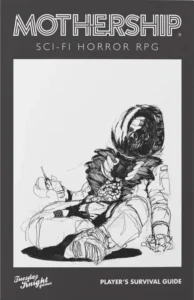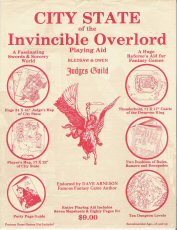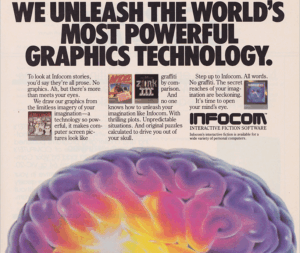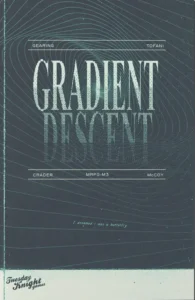Gradient Descent is a module/campaign setting/megadungeon for the SF-horror RPG Mothership, released in 2020. It is written by Luke Gearing, with art by Nick Tofani and layout by Sean McCoy, and was published by Tuesday Night Games. Dimensionally it is a tightly packed 64-page digest-sized booklet, and the PDF sells for $20, or as part of the Mothership deluxe boxed set.
‘What if Blade Runner was a dungeon crawl?’ – Greg
‘Bladerunners in the Dark’ – James
>>>>>THE AUDIO FOR THIS EPISODE IS CURRENTLY ONLY AVAILABLE TO THE PODCAST’S BACKERS. WHEN IT GOES PUBLIC, THE LINK TO THE RECORDING WILL APPEAR ON THIS PAGE. TO GET EARLY ACCESS, YOU CAN BECOME A SEASON 3 BACKER BY CLICKING HERE
SHOW NOTES
These are the notes for this episode, a chance for us to pick up the threads, fill in the blanks, throw up some links, and correct the occasional errors that we didn’t have time to deal with in the episode itself.
 Mothership is a SF-horror RPG by Sean McCoy, first released in an early version in 2018, and formally published in 2021 with a Kickstarter that raised $1.4m. It is deliberately bare-bones and old-school in design and presentation, but at the same time its stripped-back mechanics do a lot of the heavy lifting of generating the game’s narrative. It has become the banner-flapper for a new wave of SF RPGs in the 2020s. The Player’s Guide is a pay-what-you-want download at DriveThruRPG.
Mothership is a SF-horror RPG by Sean McCoy, first released in an early version in 2018, and formally published in 2021 with a Kickstarter that raised $1.4m. It is deliberately bare-bones and old-school in design and presentation, but at the same time its stripped-back mechanics do a lot of the heavy lifting of generating the game’s narrative. It has become the banner-flapper for a new wave of SF RPGs in the 2020s. The Player’s Guide is a pay-what-you-want download at DriveThruRPG.
 The cover of Mothership‘s core set, a skeleton in a 70s space suit, not only sets the tone of the game, but is a specific callback to a classic piece of genre art, Angus McKie’s 1976 cover to Brian Aldiss and Harry Harrison’s fiction anthology Year’s Best Science Fiction, also used as the cover of White Dwarf 17. Banger.
The cover of Mothership‘s core set, a skeleton in a 70s space suit, not only sets the tone of the game, but is a specific callback to a classic piece of genre art, Angus McKie’s 1976 cover to Brian Aldiss and Harry Harrison’s fiction anthology Year’s Best Science Fiction, also used as the cover of White Dwarf 17. Banger.
Mothership follows an interesting third-party publishing model, falling between the old-school ‘you need a licence, pay us’ of the previous century, and the modern ‘trademark, what trademark’ model of PBtA, Carved from Brindlewood and others. Anyone can create material for Mothership, and if the game’s publisher Tuesday Knight Games approves it then you can release it with the Mothership logo on the cover, without paying them any fees or royalties. This has given the RPG a wide range of consistently high-quality material, which is not the case with, say, PBtA or the D&D Open Licence.
Psychological horror in RPGs dates back to the 80s and the better class of Call of Cthulhu supplement, as well as some fantasy adventures for more trad systems including D&D and Warhammer FRP, but too often horror in RPGs has meant using the tropes of the genre without engaging or understanding what actually gives those things their power. (Probably the worst example is the AD&D Monster Manual, where creatures that lurk in the subconscious are packaged alongside the most hackneyed kind of fantasy hodge-podge, like some kind of catalogue of interchangeable parts.) As James says too much, interactive storytelling is different to traditional narrative techniques, and the things that make a horror novel or movie scary may not work when reworked for a tabletop RPG or computer game where you’re seeing the world through the character’s eyes or making their decisions for them. Mechanics like Mothership‘s d100 Panic Engine do a lot to replicate the feel of classic SF horror movies but at the expense of the players’ control of their characters.
 Judges Guild was one of the first third-party companies to produce ‘official’ materials for RPGs, mostly D&D and AD&D, starting in the late 1970s. Its defiantly old-school attitude was its demise: it refused to modify its bare-bones basic attitudes to fantasy adventuring in the face of better written and better produced materials in the early 1980s, and was on the rocks by 1985. Of its over 250 releases very few are any good, but the ones that are include early works by Jenelle Jaquays (Dark Tower, Caverns of Thracia), the City-State of the Invincible Overlord (various authors, 1976), Tegel Manor and the catchily titled The Thieves of Fortress Badabaskor (various authors, 1978).
Judges Guild was one of the first third-party companies to produce ‘official’ materials for RPGs, mostly D&D and AD&D, starting in the late 1970s. Its defiantly old-school attitude was its demise: it refused to modify its bare-bones basic attitudes to fantasy adventuring in the face of better written and better produced materials in the early 1980s, and was on the rocks by 1985. Of its over 250 releases very few are any good, but the ones that are include early works by Jenelle Jaquays (Dark Tower, Caverns of Thracia), the City-State of the Invincible Overlord (various authors, 1976), Tegel Manor and the catchily titled The Thieves of Fortress Badabaskor (various authors, 1978).
People have been trying to capture the spirit of Ridley Scott’s Alien in an RPG ever since RPGs and Alien became things – Traveller did it, TSR did it, and we discussed some versions when we went over the scenario Alien: Chariot of the Gods earlier this season (episode 6).
No matter what the genre, the characters played by Harry Dean Stanton were always memorable and often lived by a code, which makes roleplaying them a cinch.
Callbacks are a simple narrative technique of referring back to something earlier in the work or even another work. Sometimes this is for plot advancement, sometimes for story- or world-coherence, sometimes to reassure you that the writer is actually paying attention, and sometimes for fan-service. When the androids in Gradient Descent bleed a white fluid, that is a clear callback to the synthetic Ash in Alien, who memorably did the same. It does not add anything to the story, but helps to remind players that this a familiar universe, if not a comfortable one.
 Infocom created text adventures for home computers in the 1980s and early 1990s, and wrote some snappy ad copy for them too. The point is a good one: you can still do more with words+imagination than the most cutting-edge graphics in the world.
Infocom created text adventures for home computers in the 1980s and early 1990s, and wrote some snappy ad copy for them too. The point is a good one: you can still do more with words+imagination than the most cutting-edge graphics in the world.
Gradient Descent and a lot of the Mothership adventures are based on the principles of New School Renaissance (NSR) design, centred around player-focused narrative and emergent storytelling, with no pre-written plot or story. This goes further than traditional RPG emergent-narrative techniques like Jaquaysing. Is that better than a pre-written plot? Sometimes. When it’s good it can be very good, but when the illusion is broken and it becomes clear that there’s no purpose, direction or destination to the story, just one thing happening after another, and a group of characters in search a plot, it’s a waste of everyone’s time.
‘Antagonistic play’ refers to a style of roleplay where the gamesmaster is adversarial to the players’ characters and wants them to fail. Although usually seen as a facet of early RPGs, it has been built into some RPGs as a core part of the design, notably Paranoia (Costikyan, 1984).
Fluffing the Bends roll and discovering you’re an android – James likened this part of Gradient Descent to discovering you’re the killer in a murder-mystery game, specifically Cluedo: you discover it when other people discover it, you have no time to process or react, and the fact that it’s random makes the whole narrative leading up to that point irrelevant and meaningless in retrospect. It’s not so important in Cluedo, which is less of a narrative game and more a logical puzzle with an unnecessary board, but for games with more characters and story it’s very jarring. The Decipher ‘How To Host A Murder‘ games were divided into four chapters and the player playing the murderer discovered the fact at the start of chapter 3, which sort of worked but still forced the player to rethink how they were playing the role, and given that it was at a dinner party, there was a reasonable chance they had to do it while a bit drunk.
Sandy Petersen created Call of Cthulhu in 1981, using the Basic Role Playing ruleset from Runequest, no doubt because of the obvious overlaps between bronze-age tribal society and jazz-age occultism. He went on to be part of the development team on Doom, the 3D shooter that changed the world, then worked on Age of Empires, and has latterly returned to the Lovecraft mythos with games like Cthulhu Wars.
Zardoz is a 1974 SF film written and directed by John ‘Excalibur‘ Boorman, starring Sean Connery and Charlotte Rampling, from the pre-Star Wars era when SF could be incredibly weird and didn’t revolve around PG ratings. It is memorable without being interesting or good: the memes are better than the movie. Boorman made it after his attempt to film The Lord of the Rings fell through, and we should probably be grateful for that. Source of the line “I have seen the future and it doesn’t work.”
SI: Tomb of Horrors is an early (1975) D&D adventure written by Gary Gygax, with a deserved reputation as the first and possibly greatest ‘killer dungeon’. The adventurers must find and explore the tomb of the lich Acererak. Almost everything in there exists to kill them, and if they find anything that doesn’t then they should be very suspicious. James has a plan to do live speed-runs of it at conventions, in the same way people speed-run classic video games.
Note for UK listeners, when Ross and Greg say ‘minitar’ they mean ‘minotaur’.
We’ve talked about the movie Stalker in previous episodes (directed by Andrei Tarkovsky, based on the book Roadside Picnic by Arkady and Boris Strugatsky) and the RPGs that have drawn from it, mostly the official Stalker RPG. Do not go and see Stalker expecting wham-bam hijinks with bizarre alien technology. It is long, slow, meditative and beautiful, while at the same time providing a rich vein of inspiration for Zone-based narrative games. (It also contains one of James’s two favourite shots in cinema: three men sit in a room; after a while it begins to rain; after a while it stops. His other is the falling rocket in Koyaanisqatsi.)
Split Second is a fun but ultimately unsatisfying 1992 SF/horror movie set in a flooded London in the year 2008, and since James was living in London in 2008 we can tell you that it’s pretty accurate (flooded streets, alien demons, gun-happy cops, Kim Cattrall) except there weren’t as many hovercrafts in the real one. As usual with Rutger Hauer movies, the main reason to watch it is Rutger Hauer.
‘I can re-sleeve you’ is a reference to Eclipse Phase, the RPG we reviewed in season 2 episode 7, and its core concept that in the future human consciousnesses can be transferred between custom-made physical bodies known as ‘sleeves’.
Scary Stories to Tell in the Dark is a series of anthologies of horror stories aimed at children, ranging from folklore and urban legends to original creations by the author Alvin Schwartz. They were originally released in the 1980s with illustrations by Stephen Gammell, but were reissued in 2011 with new art by Brett Helquist. Influential enough to spawn a well-regarded juvenile scary movie in 2019.
Thank you for listening! The hosts of this episode were Ross Payton, Greg Stolze and James Wallis, with audio editing by Ross and show notes by James. We hope you enjoyed it. If anything in this podcast or these notes has spurred your interest then we invite you to come and chat about it on our friendly Discord.
If you click on any of the above links to DriveThruRPG and buy something, Ludonarrative Dissidents will receive a small affiliate fee. You will not be charged more, and the game’s publisher will not receive less, it’s a win-win-win. Thank you for supporting the podcast this way.
